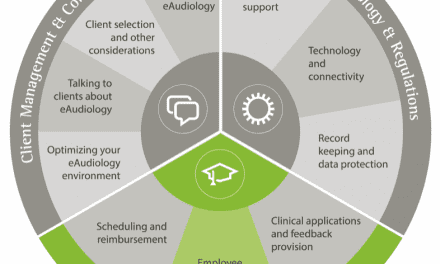Phonak ABCs of eAudiology #2: 10 Steps to Optimizing Your eAudiology Practice Environment (Practice Setup, Video Call Etiquette, & Body Language)
The Phonak ABCs of eAudiology is a handbook of step-by-step guides for incorporating eAudiology and Phonak eSolutions into daily hearing care practice. Each guide has been written by a renowned international expert in this field. A comprehensive range of considerations have been broken down into easy-to-follow steps towards practice implementation. Following the 10 steps in this series of implementation guides could see hearing care professionals up and running with eAudiology services in your practice very soon, benefiting from improved workflows and cost savings, providing your clients quality care in a way which is most convenient to them.
When planning an optimal space to practice eAudiology, consider function, practicality, and human factors. Here are 10 steps to consider when optimizing your eAudiology practice environment to facilitate clear, open, and caring communication.
Where to start?
Step 1 –
WHO?
Consider the patient/client population(s) that you will be delivering services to. Vision, mobility, and varying degrees of hearing impairments may influence your setup needs and use of multimodal communication.
Step 2 – WHAT?
Consider the types of eAudiology services you want to deliver to more effectively plan out the space and equipment needs. Consider the communication modality(s) being used and the number of healthcare practitioners that will be involved in the appointments.
Step 3 – LISTEN
Find a space that is free of competing sounds, separate from other busy practice spaces, that can be closed off (eg, includes a door or effective partition). A quiet space will reduce noise distraction and help ensure privacy.
Step 4 – LOOK
The space should be well lit for video-based appointments. Proper lighting can help ensure that the patient/client isn’t straining to see you and feels comfortable during the appointment.
Step 5 – STRATEGIZE
Strategically plan and place your equipment and furniture. Ensure the equipment is well organized, positioned on a stable surface, and within easy reaching distance. Access to hands-free telephone use and well-positioned video cameras/microphones can maximize both audio- and video-based communication, for example.
Step 6 – DESIGN
Ensure your practice space, including the backdrop for video and desk surface, is free of distraction and with limited reflection from surfaces. Remove clutter, choose your paint color/decorations wisely, and try to position cameras to minimize reflection (eg, facing a wall instead of a window).
Step 7 – DRESS
Remember to dress appropriately and look presentable when using video-based communication. Consider wearing neutral clothing free of loud prints and colors.
Step 8 – POSITION
Proper camera placement can ensure a close-up view of you (aim to include your head and shoulders). Practice optimal self positioning to enable a view of the patient/client on a display, while maintaining eye contact via the camera. Consider your posture and other cues that can help to enhance patient/client-provider relations. When conducting audio-based appointments, consider that all pauses will be heard as silence—let the patient/client know that you are pausing to think/reflect and acknowledge your engagement.
Step 9 – TRIAL
Have a trial run to test your setup, equipment, and etiquette. Consider asking a colleague to be on the other end of a mock eAudiology appointment and to offer feedback/suggestions on whether you have optimized your environment, including your use of clear speech.
Step 10 – CONFIRM
Ask the patient/client at the start of each appointment if they can comfortably see and hear you. Check the equipment regularly and before each appointment.
Are you up to the challenge?
If you are just starting out, consider repurposing a storage room, closet, or underutilized practice space. Once you have identified the space for your ideal eAudiology environment, start at Step 1!
To download a PDF of the article, please click here: 10 Steps to Optimizing Your eAudiology Practice Environment (Practice Setup, Video Call Etiquette, & Body Language)
Other Articles in the Phonak ABCs of eAudiology series below:
| 1. | Licensure and Stakeholder Support | William Campbell |
| 2. | Optimizing Your eAudiology Environment | Danielle Glista, PhD |
| 3. | Clinical Applications and Feedback Provision | Gurjit Singh, PhD |
| 4. | Employee Training | Karen Muñoz, EdD |
| 5. | Scheduling and Reimbursement | Rachel Higginbotham, AuD |
| 6. | Technology and Connectivity | Jean Anne Schnittker, AuD |
| 7. | Talking to Clients about eAudiology | Gina Angley, AuD |
| 8. | Client Selection and Other Considerations | Evelyn Davies-Venn, PhD |
| 9. | Family-centered Care and eAudiology | Joseph Montano, EdD |
| 10. | Record Keeping and Data Protection | William Campbell |
About the Author: Danielle Glista, PhD, is a Senior Research Associate and Adjunct Professor at Western University’s National Centre for Audiology in London, Ontario, Canada. Dr Glista’s research interests include hearing aid fitting and verification strategies, advanced hearing aid technologies, and aided outcome measurement for children and adults with hearing loss. Dr Glista’s recent research efforts have focused on factors influencing the clinical implementation of teleaudiology services including remote hearing aid fitting technology.






